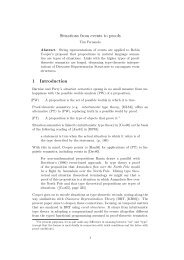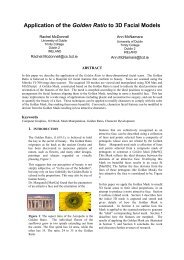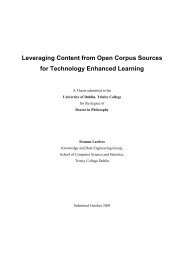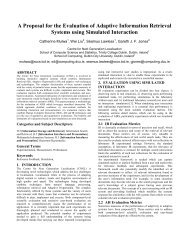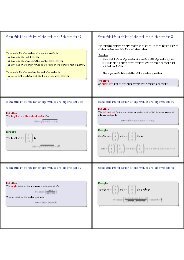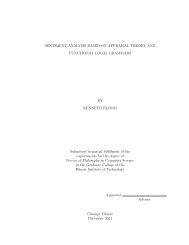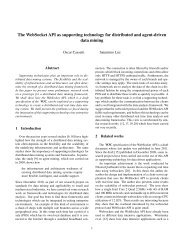Numerical Differentiation First Derivative Second Derivative Error ...
Numerical Differentiation First Derivative Second Derivative Error ...
Numerical Differentiation First Derivative Second Derivative Error ...
You also want an ePaper? Increase the reach of your titles
YUMPU automatically turns print PDFs into web optimized ePapers that Google loves.
Truncation <strong>Error</strong>s III<br />
Introduction<br />
So<br />
y(x n+1 ) − y n+1 ∝ O(h 2 )<br />
We saw that the local truncation error for Euler’s Method is O(h 2 ).<br />
By integration (accumulation of error when starting from x 0 ), we see that global<br />
error is O(h).<br />
As a general principle, we find that if the Local Truncation <strong>Error</strong> is O(h p+1 ), then the<br />
Global Truncation <strong>Error</strong> is O(h p ).<br />
Considering the problem of solving differential equations with one initial condition, we<br />
learnt about:<br />
Lipschitz Condition (unicity of the solution)<br />
finding numerically the solution : Euler method<br />
Today is about how to improve the Euler’s algorithm:<br />
Heun’s method<br />
and more generally Runge-Kutta’s techniques.<br />
Improved <strong>Differentiation</strong> Techniques I<br />
Improved <strong>Differentiation</strong> Techniques II<br />
We can improve on Euler’s technique to get better estimates for y n+1 . The idea is to<br />
use the equation y ′ = f(x, y) to estimate the slope at x n+1 as well, and then average<br />
these two slopes to get a better result.<br />
k1<br />
(e)<br />
y n<br />
y n+1<br />
0.5(k1+k2)<br />
x n<br />
y n+1<br />
x n+1<br />
k2<br />
Using the slope y ′ (x n , y n ) = f(x n , y n ) at x n , the Euler approximation is:<br />
(A)<br />
y n+1 − y n<br />
h<br />
≃ f(x n , y n )<br />
Considering the slope y ′ (x n+1 , y n+1 ) = f(x n+1 , y n+1 ) at x n+1 , we can propose this<br />
new approximation:<br />
(B)<br />
y n+1 − y n<br />
h<br />
≃ f(x n+1 , y n+1 )<br />
The trouble is: we dont know y n+1 in f (because this is what we are looking for!).<br />
So instead we use y (e)<br />
n+1 the Euler’s approximation of y n+1:<br />
(B)<br />
y n+1 − y n<br />
h<br />
≃ f(x n+1 , y (e)<br />
n+1 )<br />
Improved <strong>Differentiation</strong> Techniques III<br />
Runge-Kutta Techniques I<br />
So considering the two approximations of yn+1−yn<br />
h with expressions (A) and (B), we get<br />
a better approximation by averaging (ie. by computing A+B/2):<br />
Heun’s Method.<br />
The approximation:<br />
y n+1 − y n<br />
h<br />
y n+1 = y n + h 2 ·<br />
is known as Heun’s Method.<br />
≃ 1 (<br />
2 · f(x n , y n ) + f(x n+1 , y (e) )<br />
n+1<br />
(<br />
f(x n , y n ) + f(x n+1 , y (e) )<br />
n+1<br />
= y n + h 2 · (f(x n, y n ) + f(x n+1 , y n + h · f(x n , y n ))<br />
It can be shown to have a global truncation error that is O(h 2 ). The cost of this<br />
improvement in error behaviour is that we evaluate f twice on each h-step.<br />
We can repeat the Heun’s approach by considering the approximations of slopes<br />
in the interval [x n ; x n+1 ].<br />
This leads to a large class of improved differentiation techniques which evaluate f<br />
many times at each h-step, in order to get better error performance.<br />
This class of techniques is referred to collectively as Runge-Kutta techniques, of<br />
which Heun’s Method is the simplest example.<br />
The classical Runge-Kutta technique evaluates f four times to get a method with<br />
global truncation error of O(h 4 ).



